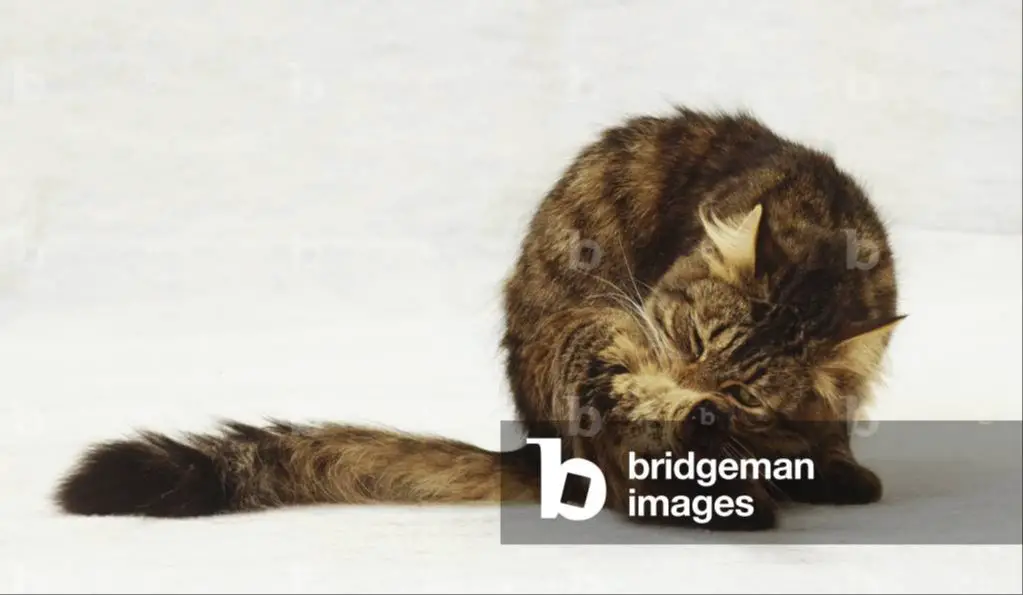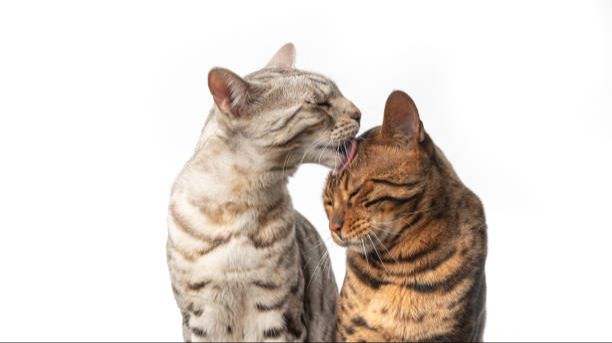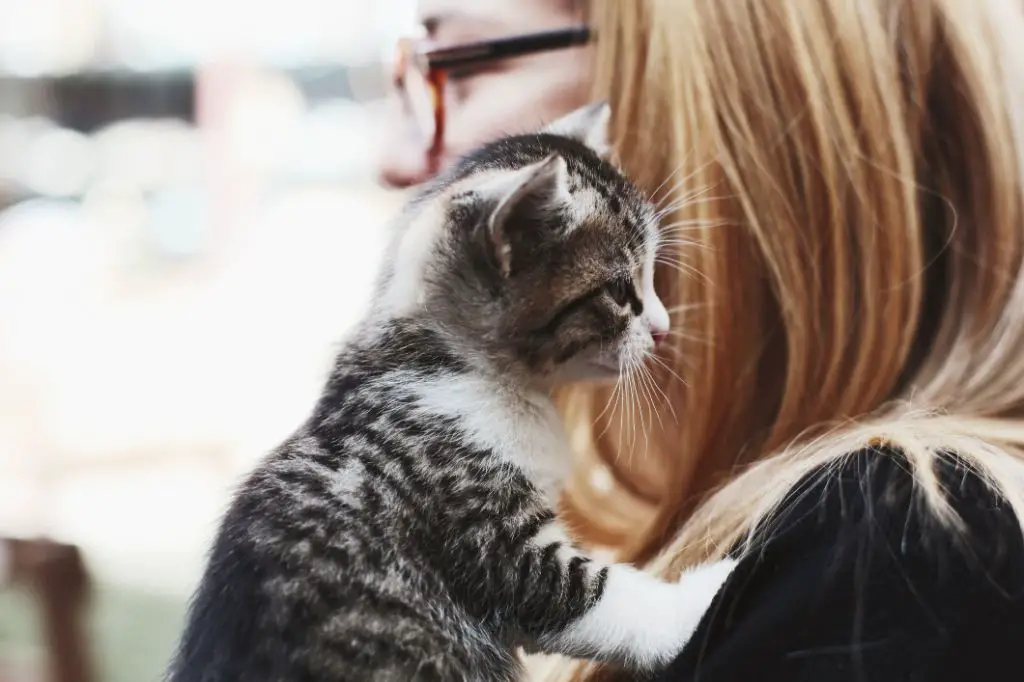Cats have an instinctive behavior of licking themselves and others. Cat owners are often recipients of these licks, and may wonder if they should read into these wet kisses. While licking serves practical functions for cats like grooming, it can also be a sign of affection. Some funny stories point to the quirky nature of feline licking habits.
For example, one cat owner shared how their cat licks the husband’s armpits while he sleeps (https://www.buzzfeed.com/lorynbrantz/16-hilarious-cat-stories-that-prove-cats-are-the-weirdest). Another Reddit user posted about their cat insistently licking the bottom of their shoe, dubbing her the “dumbest creature I’ve ever met” (https://www.reddit.com/r/WhatsWrongWithYourCat/comments/u62mp7/my_husband_pointed_out_that_our_cat_was_just/). These lighthearted anecdotes show the peculiarities of cat licking behaviors.
Cats Groom Themselves by Licking
Cats spend much of their waking hours cleaning and grooming themselves. This self-grooming serves several purposes for cats. One of the main reasons cats lick themselves is to keep their coats clean and free of dirt, debris, and parasitic organisms like fleas. Cats have barbed tongues that are ideal for removing loose hair, dust, and dander. The saliva deposited during licking also helps smooth the fur and remove tangles or mats.
Cats tend to groom in a fairly set pattern, starting with the head, chin, and ears. They then move down the body, licking the shoulders, torso, legs, paws, and genital area. Cats are extremely flexible, which allows them to twist and turn to reach all parts of their body with their tongue. The grooming ritual serves as a relaxing, calming activity for cats as well. The rhythmic motion of licking releases endorphins that lower stress levels. Many cats will over-groom due to anxiety or stress.

Besides keeping the coat clean, a cat’s saliva also helps condition the fur and skin when distributed during grooming. The proteins and enzymes in saliva moisturize the skin. Saliva helps maintain the correct pH balance on the skin as well. Regular grooming helps cats remove loose hair and prevent hairballs from forming when the hair is ingested. Most cats are fastidious groomers and keep themselves immaculately clean through frequent self-licking.
Cats Groom Other Cats by Licking
Cats engage in social grooming behavior called allogrooming, where they lick and groom other cats. Allogrooming strengthens social bonds between cats and is an important part of cat society.
When a cat grooms another cat, the groomer will often approach with a vertically raised tail as a friendly greeting. Most allogrooming is focused on the head, neck, and shoulders. The cat being groomed will reciprocate the grooming or simply enjoy the care. https://lizskittybootcamp.com/2022/11/22/allogrooming-allorubbing/

Cats allogroom for several reasons: to bond with other cats, to scent mark group members, to remove dirt and parasites, and to provide comfort and relaxation. It helps establish social hierarchies and relationships within a group of cats. Allogrooming releases endorphins that relieve stress for both cats.
Kittens allogroom their mothers and littermates from a very young age. Adult cats will allogroom cats they are close with, such as siblings, offspring, or mates. However, not all cats enjoy allogrooming and some may avoid or refuse being groomed by other cats.
Cats Lick People as a Social Behavior
Cats often lick their owners as a way to create a social bond and show affection. From a young age, a mother cat would lick her kittens as a way of grooming them and showing care. This behavior continues into adulthood as a way cats strengthen social connections.
Licking is thought to release pheromones that help cats identify members of their social group. According to Purina, “When your cat licks you they are essentially marking you with their scent which makes you a part of their community and family.”[1] So licks are like kitty kisses that say you belong to them.

Cats may also lick their owners to get attention, as a greeting when you get home, or as a request for food or playtime. Excessive licking can be a sign your cat is bored or stressed. But in general, licks from your cat are a sign they feel safe and attached to you.
[1] https://www.purina.co.uk/articles/cats/behaviour/understanding-cats/why-does-my-cat-lick-me
Licking as Affection
A cat’s licking behavior serves several purposes, one of which is to show affection. When cats lick each other or their human companions, it often indicates positive social behavior and bonding. Cats have scent glands in their cheeks, so licking deposits their scent on the other cat or person as a way to mark them as part of their social group.
Licking also releases pleasurable endorphins in the cat’s brain that make them feel relaxed and content. According to Too Much Licking – Academy Animal Hospital, studies show that the act of licking causes the release of endorphins that provide a calming effect for the cat. So licks are like kitty kisses that make the cat feel good. Gentle licks on a human hand or arm can signify affection, friendship and happiness in the cat.
Licking and Scent-Marking
Cats have scent glands in their cheeks and paws. When they lick objects, people, or other cats, they deposit some of their scent. This is a normal feline social behavior that marks their territory and objects of affection. As stated by Purrinlot, “This is called scent marking. Cats have a favorite scent – their own. So even after grooming, a cat will try to lick every spot in its body. If they can’t lick a spot, they’ll rub it on something” (https://www.purrinlot.com/scent_marking.htm).
By licking their owners, cats are engaging in scent-marking and claiming them as part of their territory. According to Sheba, “The more a cat scents you through licking, the more they are laying claim to you as part of their feline tribe” (https://www.uk.sheba.com/blog/bonding-care/why-do-cats-lick-you-what-does-it-mean). This social bonding activity also occurs between cats, as Quora confirms: “It’s a very typical social bonding activity for cats to groom each other” (https://www.quora.com/Do-cats-Felis-silvestris-lick-other-cats%E2%80%99-scent-marks-in-order-to-get-a-better-%E2%80%9Cpicture%E2%80%9D-of-the-scent-owner).
Licking as Grooming Behavior
Cats spend much of their waking hours grooming and licking themselves. Their tongues have small, hook-like barbs that help remove dirt and loose fur when grooming. Licking helps distribute natural oils across their coat to condition fur and skin. Mother cats will also lick newborn kittens as part of post-birth care to help dry, warm, and stimulate them.
Beyond keeping themselves clean, cats use licking and grooming to bond with other cats. Mutual grooming sessions help establish relationships within a group and reinforce social hierarchies. Cats have scent glands around their head and neck, so licking these areas exchanges scents and mixes the group scent profile.
Sometimes cats extend this grooming behavior to humans, especially owners they have bonded with. Cats may try to lick people’s hair or gently nibble on hands, feet, and other body parts. From the cat’s perspective, this shows affection and an attempt to integrate the human into the social group scent. However, too much licking from a cat can be bothersome for owners.

Source: https://www.quora.com/Why-does-a-cat-s-mom-lick-and-bite-its-kitten
When Licking Becomes Problematic
Sometimes a cat’s licking behavior can become obsessive and problematic, which is a condition known as pica. Pica is defined as the consistent chewing, sucking, or consumption of inappropriate and inedible materials, most commonly seen with wool, plastic, or fabric (PetMD, https://www.petmd.com/cat/conditions/behavioral/pica-cats). This obsessive licking and chewing is likely rooted in stress, anxiety, or boredom (iCatCare, https://icatcare.org/advice/pica-in-cats/).
Cats with pica may lick or chew on things like plastic bags, rubber bands, fabrics, carpet fibers, or even their own hair to extreme excess. This can be dangerous if they ingest any of the inedible materials. Symptoms of pica in cats include excessive licking, chewing, or eating of non-food items. The chewing and licking is persistent and difficult to interrupt.
If your cat’s licking seems obsessive or directed at dangerous objects, talk to your veterinarian. They can help determine if anxiety, nutritional deficiencies, or other issues are causing the behavior. Providing more stimulation through play, adjusting their diet, using deterrent sprays, and managing stress may help curb pica in cats.
Should I Be Concerned About Cat Licks?
While most cat licks are harmless, there is a small risk of infection from bacteria that cats carry in their mouths. One concern is Toxoplasma, a parasite that cats can transmit through feces. Humans can contract toxoplasmosis by accidentally ingesting infective parasites shed in a cat’s feces, not through direct contact like licks. However, cats groom themselves by licking so it’s possible to be exposed if they lick you right after grooming. Another bacteria is Pasteurella, which can cause skin infections if a cat’s saliva enters a bite wound or existing scratch. Most concern comes from stray cats. Overall the risk is low, especially for indoor cats, but immunocompromised people should take extra precautions like washing hands after contact.
Conclusion
In summary, cat licks can be a sign of affection, but their meaning depends on the context. Cats groom themselves by licking and will also groom other cats they are bonded with. When a cat licks a human, it is often showing social or affectionate behavior and communicating that it feels safe and connected. However, excessive licking of people can also be a sign of stress or anxiety in some cats. While many cat owners enjoy cat kisses and see them as a form of affection, others find the licking irritating. Understanding your cat’s personality and behavior is key to interpreting whether its licks are intended as feline kisses or serve another purpose.

